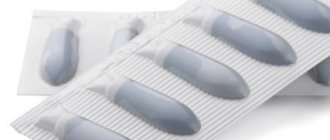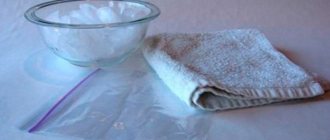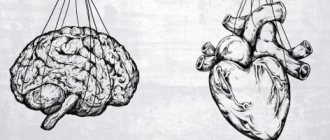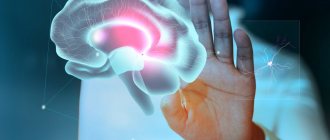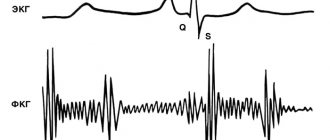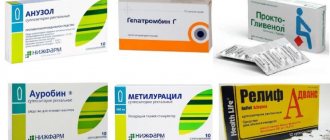All articles
Using suppositories for pain relief and treatment of hemorrhoids
26.09.2017
Suppositories for hemorrhoids are an effective treatment for the disease. The combination of various active ingredients allows you to eliminate the symptoms of the disease.
Today there are many effective ways to treat hemorrhoids. Symptoms can often be relieved with over-the-counter medications and lifestyle changes. One of the most popular remedies are suppositories, or rectal suppositories “for hemorrhoids”. Such candles have different effects and are used for specific purposes. Doctors do not recommend using several remedies to treat hemorrhoids at the same time. Also, you should not use medications containing glucocorticosteroids uncontrollably for longer than 5–7 days. Be sure to tell your doctor if your symptoms worsen while using them, such as increased itching.
The most effective suppositories for hemorrhoids according to buyers
This section includes suppositories that received the largest number of positive reviews from patients with the initial stages of the disease.
- Methyluracil is an effective drug with a pronounced immunostimulating and anti-inflammatory effect. The use of this drug allows achieving remission in 95% of patients. It accelerates the healing of damage to the mucous membrane and stimulates epithelial renewal. Another advantage of the drug is its price - less than 100 rubles.
- Nigepan. These suppositories have analgesic, anti-inflammatory and thrombolytic effects. Its cost ranges from 400 to 500 rubles.
- Proctosan is a medicinal product with a natural composition. These suppositories relieve inflammation, pain, itching, and also reduce bleeding from hemorrhoids and promote their rapid healing.
Popular treatments for hemorrhoids
This pathology is characterized by varying degrees of severity and its individual types. People with an inactive lifestyle and excess weight are at particular risk for hemorrhoids. This article will help you become more familiar with the pathology and the most effective ways to treat it, as well as popular and affordable drugs for the treatment of hemorrhoids.
Drugs for the treatment of hemorrhoids are divided into the following categories:
- Products for external use. These include gels and ointments, which also allow you to keep your underwear clean.
- Internal use products. The drug enters the intestines with the blood and has a systemic effect on internal organs. These are tablets, capsules and pastilles. There are also preparations in the form of a suspension.
- Drugs used rectally. These include suppositories (suppositories) for hemorrhoids, which are inserted into the anus. They can be monocomponent or multicomponent.
Timely diagnosis and treatment lead to better treatment results. When the first stage of hemorrhoids is diagnosed, it is enough just to relieve inflammation and strengthen the walls of the veins. Additionally, normal blood circulation in the hemorrhoid should be achieved. There are also traditional medicine methods that have a positive effect without leaving side effects. In advanced situations, surgical treatment and an integrated approach will be required.
The most popular of the above groups of drugs are suppositories. In addition, it has been proven that suppositories for hemorrhoids are the most effective and easy-to-use means for treating it. We will dwell on this group in more detail. Let's look at which of them are used in individual situations.
Rectal suppositories for severe pain syndrome
Here we will talk about a list of the most effective pain-relieving suppositories used to treat hemorrhoids.
- Proctosedyl M. The composition contains antibacterial, hormonal and analgesic substances. Due to the large number of strong active ingredients, the drug quickly relieves all manifestations of hemorrhoids, even severe ones.
- Procto-glivenol. The drug relieves intense pain and relieves patients from itching. Also, due to the presence of tribenoside in the composition, it improves blood flow in the inflamed area and eliminates swelling.
- Relief Advance - soft suppositories for hemorrhoids. Due to the content of a large amount of vegetable oils, the drug gently relieves pain and reduces inflammatory reactions.
- Relief Ultra. Unlike the previous drug, it also contains a hormonal component, thanks to which it fights the manifestations of hemorrhoids even more actively. At the same time, its cost is, of course, higher.
- Hematrombin G. The drug has a lightning-fast effect. Literally a minute after administration, it relieves itching and pain in the affected area. The effect is realized due to the content of the hormone prednisolone in the suppositories. However, these suppositories do not treat the disease, but only relieve symptoms, and therefore have a short-term effect.
Possibilities of using diclofenac suppositories in rheumatology
The mechanism of action of NSAIDs is the same for all subgroups of drugs and is based on inhibition of the enzyme cyclooxygenase (COX), which plays a key role in the synthesis of arachidonic acid metabolites, which have a pro-inflammatory effect and are directly involved in thermoregulation and the formation of pain. By inhibiting this enzyme, NSAIDs reduce the manifestations of inflammation [2].
The ability to relieve pain of various origins is the main factor in the widespread use of NSAIDs in therapeutic, surgical and rheumatological practice. Unlike narcotic analgesics, NSAIDs are not addictive and do not depress the respiratory center [3]. NSAIDs are prescribed to approximately 20% of inpatients suffering from diseases of the internal organs [3].
According to domestic authors, by the 20th year of life, every second resident of Russia has one or another rheumatic disease, and by the age of 65 this figure reaches 100%.
[4].
The main goal of drug treatment of rheumatic diseases is to relieve pain and stiffness of muscles and joints with the help of NSAIDs [5].
Comparative characteristics of some of the most commonly used NSAIDs are given in Table. 1, where they are ranked in descending order of severity of a particular action.
Thus , diclofenac is one of the most powerful non-steroidal anti-inflammatory drugs
[6]. In addition, the drug also has a very low probability of ulcerogenic effects [4].
Many years of positive experience in the use of diclofenac in different countries, the abundance of available dosage forms, a wide range of acceptable dosages - all this makes it possible to consider it the drug of first choice for most rheumatic diseases and for the relief of pain of mild and moderate intensity [1].
Diklovit
is a rectal suppository containing diclofenac as an active ingredient and used as an analgesic, anti-inflammatory and antipyretic agent.
pharmachologic effect
According to modern concepts, diclofenac has a number of pharmacological effects, the main one of which is inhibition of the activity of the COX enzyme, which catalyzes the formation of prostaglandins from arachidonic acid - powerful mediators of the inflammatory process [3]. The existence of two COX isoenzymes, COX-1 and COX-2, has been established.
COX-1 induces the production of prostanoids: prostaglandins, which have a cytoprotective effect on the gastric mucosa, and thromboxane A2, which affects platelet aggregation.
COX-2 is expressed in areas of inflammation and promotes the synthesis of pro-inflammatory prostaglandins. Thus, the anti-inflammatory effect of diclofenac is associated with the suppression of COX-2 activity
, and the development of side effects is due to the suppression of COX-1.
Diclofenac is able to cause uncoupling of oxidative phosphorylation in mitochondria with a decrease in ATP synthesis and a decrease in energy supply to the inflammatory reaction, as well as inhibit lipid peroxidation.
The ability of diclofenac to affect acute exudative inflammation by inhibiting COX makes it one of the most powerful NSAIDs used to treat diseases of the musculoskeletal system (rheumatoid arthritis, ankylosing spondylitis, etc.) [1].
Diclofenac suppresses the exudative and proliferative phases of inflammation. This reduces the formation of various prostaglandins and prostacyclins in areas of inflammation and prevents the formation of free radicals from cyclic endoperoxides and the formation of lipid peroxides in cell membranes, which leads to limitation of inflammation.
By limiting exudation, diclofenac prevents blood plasma factors from entering the tissue that stimulate enzymes that activate collagen synthesis by fibroblasts. As a result, the proliferative component of inflammation is also suppressed [7].
The immediate analgesic effect of diclofenac, as well as the anti-inflammatory effect, is mainly explained by blocking the synthesis of prostaglandins both in peripheral tissues and in the central nervous system.
The most common cause of chronic pain in old age is osteoarthritis. Due to the fact that inflammatory reactions of the synovium and periarticular tissues play a critical role in the pathogenesis of pain, diclofenac in osteoarthritis in most cases provides a more pronounced analgesic effect than non-narcotic analgesics [1]. The analgesic effect of the drug is also associated with a decrease in exudation and a weakening of mechanical pressure on pain receptors in tissues, as well as preventing the development of hyperalgesia [6].
The antipyretic effect is due to inhibition of the synthesis of prostaglandins E1 in the central nervous system and a decrease in its effect on the thermoregulation center. The antipyretic effect of diclofenac can also be explained by the inhibitory effect on the synthesis of endogenous pyrogens with a molecular weight of 10,000 - 20,000 D in polymorphonuclear neutrophils, monocytes and reticulocytes [6].
The antiplatelet effect is characteristic of all non-selective COX inhibitors and is associated with inhibition of thromboxane A2 synthesis [1, 6].
The desensitizing effect of diclofenac develops slowly. To receive it, the drug must be prescribed for 2 months or more. The following mechanisms are important in the mechanism of occurrence of the desensitizing effect:
• Inhibition of the synthesis of prostaglandins E2 at the site of inflammation and in leukocytes, as well as a decrease in the chemotactic activity of monocytes.
• Reduced formation of hydro-heptranotrienic acid, which reduces the chemotactic activity of T-lymphocytes, eosinophils and polymorphonuclear neutrophils at the site of inflammation.
• Inhibition of blast transformation of lymphocytes due to blocking the formation of prostaglandins [6, 7].
The numerous physiological functions of prostinoids determine the use of NSAIDs in various fields of medicine, in particular in gynecology. Diclofenac can be successfully used for primary dysmenorrhea, which is associated with the formation of a large amount of prostaglandins in the uterus and its increased ability to contract, which serves as the basis for treatment with prostaglandin synthesis inhibitors [1, 7].
Diclofenac is a short-lived NSAID - the half-life of the drug is 1.5-3.5 hours.
It must be borne in mind that the kinetic parameters of NSAIDs in blood serum and in synovial fluid are different. In this case, the synovial concentration of long-lived drugs correlates with the serum level, and when taking short-lived drugs it is initially low, but then increases significantly and can exceed the serum concentration. This helps explain the long-lasting clinical effectiveness of short-lived drugs [3].
Diclofenac has a high degree of absorption and bioavailability. Up to 99% of the drug is metabolized in the liver, 75% of diclofenac is excreted through the kidneys.
Thus, diclofenac is indicated as a pathogenetic or symptomatic agent:
• with inflammation of various origins;
• to relieve pain of mild or moderate severity of various origins;
• to reduce elevated body temperature (if necessary) [3].
The dosage form of diclofenac in the form of suppositories Diclovit has a number of advantages:
• Suppositories do not cause the complications that are possible with parenteral administration of drugs. Long-term use of NSAIDs is characterized by the development of muscle necrosis at the injection site. Long-term (more than 2-3 days) parenteral use is fraught with the development of infiltrates and suppuration.
• Of no small importance, especially for elderly patients, is to reduce the number of drug doses per day. Very often, suppositories are used in combination therapy: during the day the patient receives either injections or tablets, and at night - suppositories, which creates a better therapeutic effect due to a more uniform and long-term maintenance of the concentration of the drug in the blood.
• It is advisable to prescribe suppositories if it is impossible to take drugs by mouth (in weakened patients, in the presence of esophageal strictures, etc.).
• When taken orally, there is a direct damaging effect of diclofenac on the cells of the gastric mucosa with damage to mitochondria and uncoupling of oxidative phosphorylation. That is why, in the presence of signs of damage to the stomach and duodenum, preference is given to suppository forms of diclofenac [1, 5, 8].
Clinical trials of Diclovit
In studies conducted at the Department of Propaedeutics of Internal Diseases of the Moscow Dental Institute, Diclovit suppositories were used in patients with a wide range of arthrological diseases (Fig. 1). During treatment, the indicators of ESR, C-reactive protein, and blood seromucoids significantly decreased (Table 2).
The high therapeutic effectiveness of the drug was also demonstrated in studies conducted at the Institute of Rheumatology of the Russian Academy of Medical Sciences.
The identified analgesic and anti-inflammatory effect of Diclovit suppositories had a positive effect on joint function:
Exudative manifestations, the duration of morning stiffness, and the severity of pain decreased or disappeared, the range of motion in the joints increased, the number of affected joints and the degree of their functional insufficiency decreased (Fig. 2).
In a study of the effectiveness and safety of Diclovit suppositories, conducted at the Main Military Clinical Hospital. N.I. Burdenko, it is shown that the duration of action of Diclovit suppositories is longer than the duration of action of the tablet form of diclofenac.
Indications for use
• Inflammatory and degenerative joint diseases - rheumatoid arthritis, ankylosing spondylitis (ankylosing spondylitis), Reiter's disease, osteoarthritis, psoriatic arthritis, gout:
• rheumatic lesions of soft tissues - bursitis, tendovaginitis, synovitis;
• diseases of the nervous system - glenohumeral periarthritis, lumbago, lumbodynia, neuralgia, myalgia;
• gynecological diseases - primary dysmenorrhea, adnexitis, perimetritis;
• febrile conditions with infectious and inflammatory diseases of the ENT organs;
• inflammation, pain, trismus, swelling due to dental, orthopedic, gynecological and other surgical interventions.
Directions for use and dosage regimen
Having freed the suppository from the contour packaging, it is introduced into the rectum after an enema or spontaneous bowel movement. After administration, you should stay in bed for 20-30 minutes. Use 1 suppository 2 times a day. The maximum daily dose is 150 mg.
The duration of treatment is determined by the doctor depending on the severity of the disease.
Side effects and contraindications
The drug is usually well tolerated and rarely causes side effects.
However, dyspepsia, diarrhea, heaviness in the epigastrium, drowsiness, headaches and slight dizziness are possible (especially at the beginning of treatment). These phenomena usually go away on their own. In rare cases, a local irritant effect on the intestinal mucosa is possible.
Contraindications to the use of Diclovit are: peptic ulcer of the stomach or duodenum, hemorrhagic colitis, exacerbation of hemorrhoids, hematopoietic disorders of unknown etiology, increased individual sensitivity to diclofenac, acetylsalicylic acid or other NSAIDs, third trimester of pregnancy, children under 15 years of age.
Literature
1. Karateev D.E. Non-steroidal anti-inflammatory drugs // Medical newspaper. 1999; 82: 8-9.
2. Zeigarnik M.A. Cost of long-term treatment with NSAIDs: there is a choice // Remedium. 1999; 11:58-60.
3. Nasonov E.L. Non-steroidal anti-inflammatory drugs // Russian Medical Journal. 1999; T 7: 8: 392-96.
4. Kornienko V.V. Antihomotoxic therapy of rheumatic diseases // Medical Bulletin. 1996; 4:12-3.
5. Lawrence D.R., Bennitt P.N. Clinical pharmacology: In 2 volumes - M.: Medicine, 1993; T. 2: 583-84.
6. Kukes V.G. Clinical pharmacology: Textbook. / Scientific ed. Baichurina A.Z. — 2nd ed., revised. and additional - M.: GEOTAR Medicine, 1999; 528.
7. Karkishchenko N.N. Pharmacological basis of therapy (guide and reference for doctors and students). - M.: IMP - Medicine, 1996; 560.
8. Mashkovsky M.D. Medicines: In 2 volumes - 13th ed. Kharkov: Torsing, 1997; T. 1: 320.
Suppositories with diclofenac -
Suppositories with diclofenac -
Diclovit (trade name)
(Nizhpharm)
| Applications to the article |
| The most common cause of chronic pain in old age is osteoarthritis. |
| Rice. 1. Diseases for which clinical trials of the drug Diclovit were conducted. |
| Rice. 2. Dynamics of articular syndrome during treatment with Diclovit. |
Inexpensive suppositories for hemorrhoids
Most medications for hemorrhoids are quite expensive. Is it possible to find cheap and effective drugs? Of course. This section will present the most popular candles with a loyal pricing policy.
- Belladonna extract is the most natural preparation. Contains exclusively herbal ingredients and costs around 50 rubles. These suppositories relieve spasms and significantly relieve pain. However, the drug will not be able to cope with severe manifestations of the disease, so it is recommended only for mild cases.
- Betiol, like the previous type of suppositories, has a moderate analgesic and antispasmodic effect. The price does not exceed 100 rubles.
- Ichthyol. The drug effectively eliminates pain and also has an antiseptic effect.
Definition.
Anal pain, as well as pain around the anus or in the rectal area (perianal area), is a fairly common complaint.
Although most causes of anal pain are not related to serious problems, it can become a problem in itself due to the intensity associated with the presence of many nerve endings in the perianal area. Some causes of anal pain can also cause bleeding from the rectum (rectal bleeding), which is a more serious symptom.
The causes of anal pain are usually fairly easy to diagnose. It can be treated well with over-the-counter pain relievers and hot water (sitz baths).
How to insert correctly
Before using rectal suppositories, you must take a hygienic shower, paying special attention to cleansing the perianal area.
It is recommended to insert suppositories once a day after defecation in the morning or evening. If constipation occurs, it is recommended to take a mild, herbal laxative.
Attention! Most suppositories for hemorrhoids have side effects and contraindications, so their use requires mandatory consultation with a specialist. The doctor will select the most suitable drug for you, which will help you quickly cope with the disease.
Causes of back pain
The condition of your back directly depends on your lifestyle. “Sedentary” work or, on the contrary, intense physical activity can provoke the appearance of spinal diseases - osteochondrosis, spondyloarthrosis, scoliosis, etc. However, the presence of pain does not always indicate pathologies of the spinal column. According to statistics, in 80% of cases pain is episodic.
They may occur for the following reasons:
- muscle strain resulting from excessive physical activity;
- staying in an uncomfortable position for a long time;
- relapses of previous diseases;
- hypothermia (long stay in a draft, in a cold place, under air conditioning);
- stagnation of joints and muscles while working at the computer, while sleeping, etc. (when the position of the body does not change for a long time).
Pain syndrome may also indicate the presence of serious chronic pathologies.:
- diseases of internal organs, in which pain radiates to the back (gynecological diseases, neoplasms of various etiologies, pyelonephritis, pancreatitis);
- scoliosis – displacement of the spine relative to its axis;
- osteochondrosis – the result of tissue degeneration of the spinal disc;
- spondylolisthesis – displacement of vertebral structures;
- myalgia – tissue inflammation;
- Bechterew's disease (spondylitis) – inflammation of joints and ligaments;
- intervertebral hernia - disc protrusion;
- traumatic injuries;
- fractures;
- vertebral infections (syphilis, osteomyelitis, tuberculosis).
Spinal diseases that most often cause back pain
If you have persistent back pain, you should consult a doctor.
Video: “Causes of back pain”

